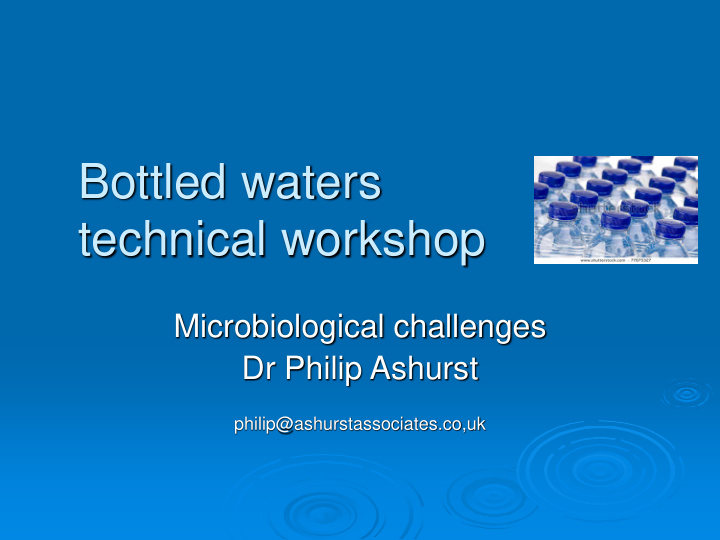



Bottled waters technical workshop Microbiological challenges Dr Philip Ashurst philip@ashurstassociates.co,uk
Effects of micro-organisms on foods Spoilage Cause illness Fermentation
Micro-organisms and water Micro-organisms need water to grow (but not necessarily survive) Importance of water activity (a w ) Minimum activities at which active growth can occur Bacteria 0.90 - 0.97 Yeasts 0.88 Fungi 0.61 – 0.88
Water activity a w Water activity definition The ratio of the vapour pressure of water in a material to the vapour pressure of water at the same temperature.
Water activity and food types a w Product types 0.9 - 1.00 Most beverages and water 0.85 – 0.95 Cured meats, ham, salami 0.75 – 0.85 Dry cheeses, flour, cakes, cereals 0.70 – 0.75 Pickles and jams 0.60 – 0.70 Dried fruits <0.60 Dehydrated foods
Microbial development factors Intrinsic Environmental Implicit Processing
Microbial development factors Intrinsic Nutrients pH Oxygen Water activity Preservatives
Microbial development factors Environmental Relative humidity Temperature Atmosphere
Microbial development factors Implicit Specific growth rate Mutualism Antagonism Commensalism
Microbial development factors Processing Filtration Irradiation/sub-micron filtration Packaging Pasteurisation
Sources of challenge Intrinsic The ingredients – is it just water or with added components? What is the end product pH? Is it above or below 4.0? Water activity – adequate to support wide range of organisms Is oxygen readily available? Are chemical preservatives, CO 2 or ethanol present?
Sources of challenge - Implicit Growth rate - 1 cell can produce 10 7 cells in 8 hours! Mutualism/antagonism/commensalism some organisms subdue or promote others. Are toxins or flavour defects possible?
Sources of challenge – Processing Filtration – what is needed (or permitted)? Removal of viable organisms – use of UV? Packaging PET or glass? Equipment automated or manual? Carbonated or still Pasteurisation Hygiene standards & CIP systems
Sources of challenge - Environment Relative humidity - it’s water! Temperature - bugs grow faster in warmer products! Atmosphere – normal, with CO 2 or nitrogen flushed?
Specific issues - The product Water - NM, Spring or bottled? • Source, composition, treatments Flavoured water? • Alcohol or PG based flavourings? Other added ingredients? What is being added? Carbohydrates and nitrogen sources provide nutrients.
Effects of microbial contaminants Haze or filament development Bottle distortion Change in aroma or taste Presence of mould pellicles
Microbial checks What to look for Water: Bacterial counts at 20°C & 37°C E.coli and presumptive coliforms Yeasts & moulds Parasites (Cryptosporidium and Giardia) Water plus: Yeasts & moulds Bacterial counts at 20°C & 37°C E.coli & presumptive coliforms (depending on pH) Parasites
What are the challenges for your products? What are you producing? How good is your hygiene? Assess the risk from ingredients Are your packaging components clean? What processing do you use? What testing do you employ? What are your complaints levels?
Thank you for your attention! Are there any immediate questions? There will be another opportunity in the panel session
Recommend
More recommend